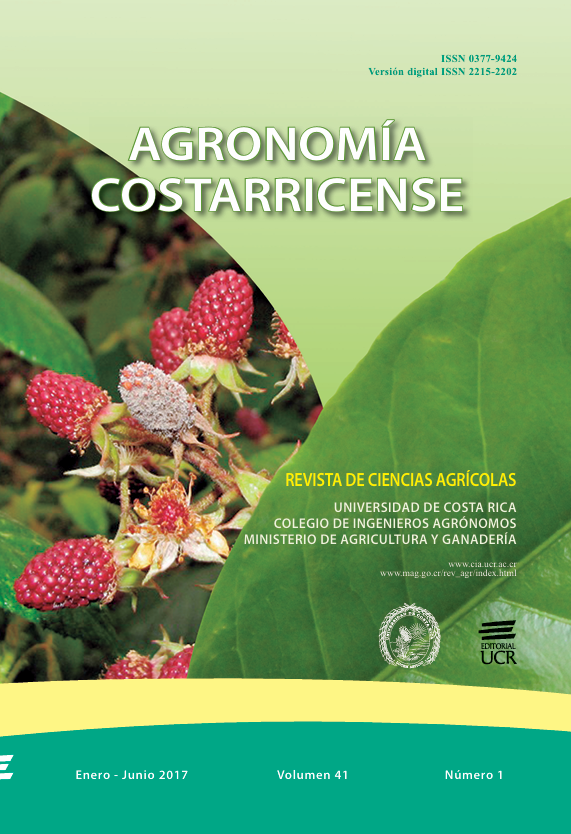Abstract
Faba bean forage productivity under different management conditions. Related to the production of Vicia faba L., beans and forage in Zaragoza, Puebla, different conditions of crop management were evaluated, such as soil preparation, fertilization and planting density. The experiment was conducted during the 2013 spring-summer crop cycle. Three variation factors were studied: 1) complete and minimum tillage; 2) compost application at 17.8 t.ha-1 and without compost; 3) planting 4, 6, 8 or 16 plants per m2. The experimental design was of randomized blocks, whith split plots and 4 replicates: large plots corresponded to 2 soil preparations, subplots to fertilization and small plots to 4 planting densities. The experimental units were plots of 3.0 x 5.6 m (16.8 m2), whose 6 central furrows were taken as the useful plot (8.4 m2). The largest production in biomass or total dry matter (10.15±1.9 t.ha-1) corresponded to treatments with complete preparation: 16 plants per m2 and application of compost (65 N; 0.54 P kg.ha-1). The dry matter production increased (p<0.05) as a function of the densities: 4, 6, 8 and 16 plants per m2, from 2.76±0.62 to 2.93±0.65.References
Altieri, MA; Nicholls, CI. 2000. Dimensiones Multifuncionales de la Agricultura Ecológica en América Latina. In: Agroecología. Teoría y práctica para una agricultura sustentable. 1 ed. Programa de las Naciones Unidas para el Medio Ambiente. Red
ESTRADA et al.: Productividad forrajera de haba de Formación Ambiental para América Latina y el Caribe. México, D. F. p. 45-55.
Bakry, B.A; Elewa, TA; El-karamany, MF; Zeidan, MS; Tawfik, MM. 2011. Effect of row spacing on yield and its components of some Faba beans (Vicia faba L.) varieties under Newly Reclaimed Sandy Soil Condition. World Journal of Agricultural Sciences 7(1):68-72.
CONEVAL (Consejo Nacional de Evaluación). 2010. Informe de la pobreza en México 2010: el país, los estados y los municipios (en línea). Ciudad de México, México. Consultado 13 jun. 2014. Disponible en http://www. coneval.org.mx/Medicion/Paginas/Medición/ Informacion-por-Municipio.aspx
Dahmardeh, MI; Mahmood, R; Jafar, V. 2010. Effect of plant density and cultivar on growth, yield and yield components of faba bean (Vicia faba L.). African Journal of Biotechnology 9(50):8643-8647.
De Giorgio, D; Fornaro, F. 2004. Tillage systems for a sustainable growth of broad bean (Vicia faba L. Major) in a semiarid region of Southern Italy. 13 International Soil Conservation Organization Conference. Brisbane. Birsbane, Australia. p. 1-4.
De Vita, P; Di Paolo, E; Fecondo, G; Di Fonzo, N; Pisante, M. 2007. No-tillage and conventional tillage effects on durum wheat yield, grain quality and soil moisture content in southern Italy. Soil and Tillage Research 92(1):69-78.
Devi, KN; Singh, TB; Athokpam, HS; Singh, NB; Shamurailatpam, D. 2013. Influence of inorganic, biological and organic manures on nodulation and yield of soybean (Glycine max Merril’L.) and soil properties. Australian Journal of Crop Science 7(9):1407-1415.
Diaz-Bautista, M; Herrera-Cabrera, BE., Ramírez-Juárez, J; Aliphat-Hérnández, M; Delgado-Alvarado, A. 2008. Conocimiento campesino en la selección de variedades de haba (Vicia faba L.) en la sierra norte de Puebla, México. Interciencia 33(8):610-615.
Duc, G. 1997. Faba bean (Vicia faba L.). Field Crops Research (53):99-109.
El-Kotb, HMA. 2013. Combination effects of tillage systems and organic manures on some physiochemical properties of calcareous soil and faba bean productivity. New York Science Journal 6(12):193-202.
El-Metwally, IM; Abdelhamid, MT. 2008. Weed control under integrated nutrient management systems in faba bean (Vicia faba) production in Egypt. Planta daninha 26(3):585-594.
Escalante, EJA; Rodríguez, GMT. 2011. Biomasa y rendimiento de haba en función de la densidad de población, nitrógeno y fósforo. Ciencias Agrícolas Informa 20:16-25.
Guadarrama, QA; Escalante, EJA; Rodríguez, GMT; Sánchez, GP; Sandoval, CE. 2007. Biomasa, proteína, taninos y rendimiento de haba en función del nitrógeno. Terra 25(2):169-175.
Hashemabadi, D. 2013. Phosphorus fertilizers effect on the yield and yield components of faba bean (Vicia faba L.). Annals of biological research 4:181-184.
Jensen, ES; Peoples, MB; Hauggaard-Nielsen, H. 2010. Faba bean in cropping systems. Field crops research 115(3):203-216.
López-Bellido, L; Benítez-Vega, J; García, P; Redondo, R; López-Bellido, RJ. 2011. Tillage system effect on nitrogen rhizodeposited by faba bean and chickpea. Field crops research 120(1):189-195.
Odabas, MS; Uzun, S; Gulumser, A. 2007. The quantitative effects of temperature and light on growth, development and yield of Faba bean (Vicia faba L.): I. Growth. International Journal of Agricultural Research 2(9):765-775.
Saxena, MC; Silim, SN; Matar, A. 1991. Agronomic management of faba bean for high yields. Options Mediterraneennes. Serie A: Seminaires Mediterraneens (CIHEAM) (10):91-96.
SAS (Statistical Analysis System Institute). 1999. SAS/STAT software, version 8. SAS Institute. North Carolina,
USA.
SIAP (Sistema de Información Agroalimentaria y Pesquera). 2014. Cierre de la producción agrícola por estado. Secretaría de Agricultura, Ganadería, Desarrollo Rural, Pesca y Alimentación (en línea). México, Ciudad de México. Consultado 14 jun. 2014. Disponible en http://www.siap.gob.mx/cierre-de-laproduccion-agricola-por-estado
Zabawi, AM; Dennett, MDD. 2010. Responses of faba bean (Vicia faba) to different levels of plant available water: I. Phenology, growth and biomass partitioning. Journal of Tropical Agriculture and Food Science 38(1):11-19.


